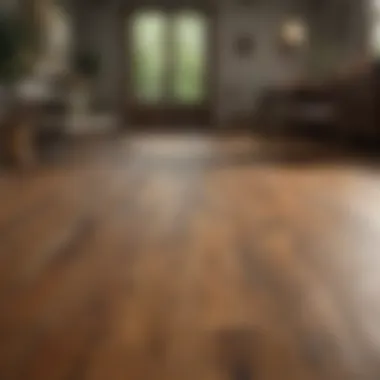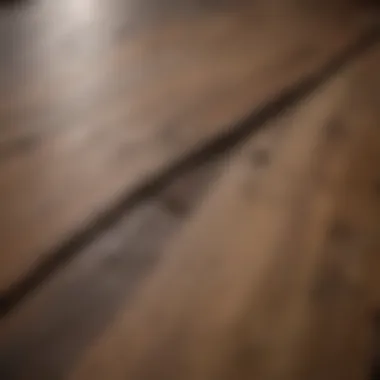Understanding Reclaimed Wood Flooring: A Sustainable Choice


Intro
Reclaimed wood flooring is not just a trendy way to spruce up a space; it’s a statement that implies a respect for the environment. This unique material is derived from previously used wood, often sourced from structures like barns, factories, and old homes. By repurposing this timber, one not only gains beautiful aesthetics but also contributes to sustainability.
In this article, we explore various aspects of reclaimed wood flooring: its definition, benefits, sourcing methods, environmental impact, and maintenance. As the demand for sustainable flooring options grows, understanding reclaimed wood becomes more essential for homeowners, builders, and forestry professionals alike.
Overview of Forestry Practices
Definition of Forestry
Forestry is the science and art of managing forests, woodlands, and associated resources to meet diverse environmental, social, and economic needs. It encompasses the planting, care, and harvesting of trees, along with the management of the wildlife and ecosystem surrounding these areas. Forestry plays a crucial role in the sustenance of our natural resources and biodiversity.
Importance of Forestry in Ecosystem Management
Forestry is not merely about logging trees. It's about striking a balance between utilization and preservation. Effective forestry practices help:
- Conserve biodiversity: Healthy forests support a wide range of species.
- Regulate water cycles: Trees act as natural water filters and help in groundwater recharge.
- Combat climate change: Forests act as carbon sinks, absorbing CO2 from the atmosphere.
These factors underscore the importance of sustainable forestry practices as we delve deeper into reclaimed wood flooring.
Sustainable Forest Management
Principles of Sustainable Practices
Sustainable forest management is centered around various core principles:
- Resource Renewal: Ensure that the rate of logging does not exceed the growth rate of new trees.
- Protection of Ecosystems: Maintain ecological processes to support wildlife and plant health.
- Community Engagement: Involve local communities in decision-making and benefit-sharing to enhance societal well-being.
Techniques in Sustainable Management
Implementing sustainable practices can take various forms, such as:
- Selective Logging: Rather than clear-cutting, certain trees are chosen for removal based on their size and health.
- Agroforestry: Combining farming with forestry to promote biodiversity and optimize land use.
- Reforestation and Afforestation: Planting new trees in logged or bare areas to restore ecosystems.
These techniques not only ensure the survival of forest resources but also contribute to the availability of reclaimed wood, a cornerstone for sustainable flooring solutions.
Woodland Stewardship Strategies
Importance of Woodland Stewardship
Woodland stewardship involves caring for forests and ensuring their health and sustainability for future generations. It encompasses both personal responsibility and broader community efforts. Good stewardship leads to improved habitat conditions, increased biodiversity, and enhanced resources for both wildlife and people.
Best Practices for Landowners
Every landowner can play a part in ensuring that their woodlands thrive:
- Conduct Regular Assessments: Understand the health of your forest and the variety of species present.
- Invove Professionals: Collaborate with forestry experts to develop a sustainable management plan.
- Educate Yourself and Others: Share knowledge about the importance of forests in the community.
"Sustainable forestry practices ensure that forests can be both utilized and preserved for generations to come."
Collectively, these sections set the stage for understanding how reclaimed wood flooring connects with sustainable forestry efforts, ideally laying a foundation to explore further into its benefits and implications.
Defining Reclaimed Wood Flooring
When speaking about reclaimed wood flooring, it is essential to lay a solid foundation in understanding what it truly signifies. Practically, this term refers to wood that has been salvaged from old structures, furniture, and other sources, repurposed for new applications, specifically flooring. The crux of it is sustainability; by reusing timber, we divert waste from landfills and reduce the demand for newly sourced lumber, which often leads to deforestation. Moreover, embracing reclaimed wood is part of a broader trend toward eco-friendly choices in home design and renovations.
Historical Context
To truly grasp the significance of reclaimed wood flooring, one must appreciate its roots. The use of wood from fallen structures or discarded items dates back centuries. Historically, wooden beams from old barns or factories have been saved not just for their sturdiness, but also for their character. This trend gained traction during the mid-20th century when the push for sustainability began to resonate within the building and design forums. The charm of weathered surfaces and unique grain patterns weren’t merely advantages— they were conversation starters that connected people to the past. Today, as sustainability continues to gain importance in our lives, reclaimed wood stands as a tangible representation of resourcefulness and history, carrying with it stories and memories embedded within its fibers.
Characteristics of Reclaimed Wood
Reclaimed wood possesses unique characteristics that set it apart from conventional flooring options. First off, each piece tells its own story, showcasing distinct imperfections that reflect its previous life. This is what often draws individuals to choose it; the authenticity and individuality it brings to a space can't be duplicated. Here are several of its defining features:
- Variety of Wood Types: Reclaimed wood can come from a smorgasbord of species, such as oak, pine, or walnut, each imparting its own flavor to the final product.
- Patina and Texture: Over the years, reclaimed wood develops a beautiful patina, which is the result of aging, exposure to the elements, and wear. This adds depth and richness that faux finishes simply can't match.
- Sustainability: As discussed, reclaimed wood provides an eco-friendly alternative, minimizing the environmental impact associated with logging and wood processing.
- Character: You won't find the same dents, knots, or nail holes in brand new wood. These imperfections add a unique character that speaks to the wood's history.


"Investing in reclaimed wood flooring is akin to purchasing a piece of history; it carries with it the essence of time, memory, and conscientious living."
By unraveling the layers of reclaimed wood flooring, we begin to see not just a material choice, but a movement toward sustainability and individuality in today's design landscape.
Sourcing Reclaimed Wood
Sourcing reclaimed wood is a vital piece of the puzzle when it comes to understanding its intricacies and benefits. Reclaimed wood flooring doesn’t just represent a material choice; it symbolizes a deeper commitment to sustainability, heritage, and craftsmanship. The sourcing process itself plays a significant role, affecting the quality, character, and environmental impact of the wood. As more individuals and businesses lean towards sustainable practices, recognizing the sources of reclaimed wood can influence not only design choices but also support communities and ecosystems.
Types of Reclaimed Wood
When looking into reclaimed wood, it’s important to distinguish the types available. Much like one might categorize fine wines or gourmet foods, types of reclaimed wood contribute to its uniqueness and value. Here are some common categories:
- Barn Wood: Sourced from old barns and agricultural structures, this wood carries with it a rustic charm, often rich in character with visible signs of wear and age.
- Cultural Buildings: Wood taken from schools, factories, and homes—historical structures that may have been demolished or renovated—can encapsulate the spirit of an era.
- Urban Salvage: This type comes from deconstructed commercial buildings or demolition sites in city environments, often yielding hardwoods like oak and maple that have been well cared for.
- Wood from Lake and River Beds: Reclaimed from underwater, this wood is naturally preserved, having spent years submerged, leading to unique colorations and textures.
Each type of wood brings its own story to the forefront, making it vital to not just understand which type you want but also where it came from.
Methods of Acquisition
Acquiring reclaimed wood involves a variety of methods, each with its own set of challenges and advantages. It’s not as simple as visiting a lumber yard; thoughtful consideration is needed in each step.
- Salvage Operations: Many businesses specialize in reclaiming wood from demolished old buildings. These operations often involve careful deconstruction methods, preserving the wood’s integrity.
- Networking with Local Contractors: Often, local builders or contractors have access to reclaimed materials that can be repurposed. Building these relationships can sometimes yield unexpected treasures.
- Auctions and Estate Sales: These events can be a goldmine for sourcing premium reclaimed wood, especially when old homes are being liquidated.
- Online Marketplaces: In today’s digital age, various websites offer reclaimed wood at competitive prices, providing a broader reach than local sourcing might allow.
In acquiring reclaimed wood, knowledge is truly power. By understanding the sourcing methods, you can better ensure the wood’s quality, authenticity, and sustainability.
"Like a finely aged spirit, reclaimed wood tells a story of time and perseverance through its grain and character."
In summary, sourcing reclaimed wood requires a nuanced understanding of both the types available and the methods used to acquire it. The more you learn, the better equipped you are to make informed, sustainable choices that enhance not only your space but also contribute to a larger ecological narrative. As the use of reclaimed wood continues to rise, so too does the responsibility to source it thoughtfully.
Benefits of Reclaimed Wood Flooring
When we talk about flooring options, reclaimed wood stands out for several captivating reasons. This article dives into the nitty-gritty of how reclaimed wood flooring not only enhances spaces but also contributes significantly to ecological and aesthetic values. It's more than just a way to dress up a room; it's a statement about sustainability and historical continuity as well.
Environmental Impact
The environmental benefits of using reclaimed wood flooring cannot be overstated. Sourcing from existing wood means less reliance on logging and reduces the demand for mass-produced wood which can lead to deforestation. By choosing reclaimed wood, one is inherently supporting forest conservation efforts. Imagine a tree that has withstood the test of time being transformed into unique flooring, thus preserving its legacy in a new form.
Reclaimed wood also contributes indirectly towards carbon sequestration. Each piece of reclaimed wood that is reused signifies a minus in emissions that would have occurred from harvesting new trees. Moreover, the process of recycling wood tends to consume less energy compared to that of processing new materials. To put it bluntly, installing reclaimed wood flooring is like giving Mother Nature a high-five. Its positive footprint is both historical and ecological.
Aesthetic Appeal
The aesthetic charm of reclaimed wood flooring is truly unmatched. Each plank carries its own history, filled with rich textures and distinct patterns that new products simply can't replicate. The natural aging process yields a variety of colors and grains, producing surfaces that can range from rustic to elegantly refined.
Utilizing reclaimed wood offers versatility in design. Whether you're aiming for a cozy, country-style kitchen or a sleek, contemporary living room, reclaimed wood can blend seamlessly into many aesthetics.
"There is beauty in imperfection; the knots, grooves, and signs of previous life add character, a narrative in each swipe of the grain."
The uniqueness of each board tells its own story and invites curiosity, making reclaimed wood an amazing choice for those who wish to infuse personality into their spaces.
Durability and Longevity
Another vital consideration is the durability of reclaimed wood flooring. Many pieces of reclaimed timber are sourced from older structures like barns or factories. These woods often come from slow-growing trees, which means they are denser and tougher than fast-grown alternatives found in modern forests. It’s said that some of these timbers can outlast the average lifespan of manufactured flooring.
When properly cared for, reclaimed wood can endure the rigors of daily life and still look appealing for decades.
Regular maintenance, such as refinishing and periodic cleaning, can ensure these beautiful surfaces remain in tip-top shape. Additionally, opting for reclaimed wood flooring is a nod towards the philosophy of longevity over consumption—one investment can yield value for years to come.
Installation Considerations
When it comes to reclaimed wood flooring, installations aren’t just about nailing down some planks. There’s a lot at stake. Proper installation not only ensures that the flooring lasts but also enhances its appeal and preserves its unique character. Getting these factors right can make all the difference between a job well done and a real headache down the road.
Preparation and Inspection
Before laying down the first plank, preparation stands as a crucial first step. You can’t just jump in without first knowing what you're dealing with. Inspecting the wood is key – it needs to be free from mold, significant damage, or warping. Here’s a simple list of what to check for during preparation:
- Moisture Content: Aim for a moisture level of around 6-8%. Too high, and you run the risk of cupping or splitting later on.
- Condition of the Subfloor: Ensure it’s clean, dry, and level. Any unevenness could lead to significant issues with the planks laying flat.
- Acclimation: Let the wood sit in its new environment for at least a week. This helps it adjust to temperature and humidity so it won’t expand or contract much post-installation.
Taking the time to thoroughly prepare might feel tedious, but it’s really a small price to pay when considering the overall outcome of the installation.


Techniques for Installation
Once the groundwork is laid, you can start with the installation itself. There are several techniques to consider, depending on factors like the wood's character and the space's design. Below are a couple of popular methods:
- Nail Down: This method involves using an angle nailer to secure the planks directly to the subfloor. It’s effective for thicker boards and allows for natural movement.
- Glue Down: Great for thin or fragile reclaimed woods, this method uses adhesive to bond the wood to the subfloor. It’s best on concrete subfloors.
- Floating: In this approach, planks are not attached to the subfloor. Instead, they are connected to each other with adhesive or locking systems, allowing for expansion and contraction.
Selecting the right installation technique depends on the unique properties of the reclaimed wood. Different species react differently to environmental changes, so choose wisely!
Professional vs. DIY Installation
The choice between professional installation and a do-it-yourself (DIY) approach can be a bit of a toss-up. Each has its pros and cons.
Professional Installation:
- Expertise: Professionals have experience with various wood types and technologies, leading to a generally higher quality finish.
- Time-Saving: Hiring an expert can be a huge time-saver, especially if you're juggling a busy lifestyle.
DIY Installation:
- Cost-Effective: If you're strapped for cash, doing it yourself cuts out labor costs. Just make sure you have the right tools and skills.
- Personal Satisfaction: There’s a certain pride that comes from doing it yourself. Plus, you can personalize the installation to your unique vision.
Ultimately, it comes down to assessing your skills, time, and budget. If you're unsure about your woodworking prowess, leaning on a pro might save you headache in the long run.
"In most cases, the effort put into prepping and installing reclaimed wood properly pays off with a stunning result that lasts for years."
In summary, while the installation of reclaimed wood flooring seems straightforward, it’s far from simplistic. Attention to detail during preparation and installation phase is crucial. This goes a long way toward ensuring that the distinct character and beauty of reclaimed wood can truly shine.
Maintenance and Care
When it comes to reclaimed wood flooring, maintenance and care are not just afterthoughts; they are essential components that ensure the longevity and beauty of your flooring investment. Like a worn leather jacket that only gets better with age, properly maintained reclaimed wood improves in character and charm, providing both aesthetic pleasures and functional integrity.
One of the primary elements to consider in maintaining reclaimed wood flooring involves understanding its unique properties compared to traditional hardwoods. Many of these planks have weathered the storm, so to speak, having been salvaged from structures that once served a purpose long before they graced your home or business. This rich history can manifest in various textures, colors, and potential vulnerabilities.
By implementing effective cleaning techniques and setting a schedule for periodic assessments, you can preserve the integrity of the wood without sacrificing its rustic allure.
Cleaning Techniques
Cleaning reclaimed wood requires a delicate touch akin to polishing a fine piece of artwork. Generally, the first step is to remove dust and debris using a soft-bristle broom or a vacuum cleaner equipped with a soft brush attachment. Avoid using a vacuum with a beater bar, as this could scratch the wood’s surface.
For deeper cleaning, a damp mop with a mild solution of pH-balanced soap or a product specially designed for wood floors can be effective. It’s crucial to ensure the mop isn’t soaking wet—moisture can seep into the seams of the wood and cause warping over time.
Recommended cleaning products:
- Bona Professional Series Hardwood Floor Cleaner
- Murphy Oil Soap
- Concrobium Mold Control (for areas prone to humidity)
Tips for effective cleaning:
- Always test cleaning solutions on a small, inconspicuous area first.
- Clean spills promptly to prevent staining or permanent damage.
- Avoid harsh chemicals; they can strip the finish and appeal of your flooring.
"A proactive approach to cleaning can save significant time and costs in the long run, prolonging the life of your reclaimed wood flooring."
Periodic Assessments
Periodic assessments of your flooring are a fundamental practice. Much like staying on top of your health, keeping an eye on the state of your wood can prevent small issues from blossoming into major headaches. This process involves checking for signs of wear, warping, and even pest infestations. Regularly scheduled inspections—ideally every six months—allow homeowners to catch problems before they escalate.
When assessing your reclaimed wood flooring, consider:
- Visual Inspection: Look for any surface scratches, dents, or signs of water damage.
- Feel Test: Run your hand across the floorboards; if you feel unevenness, it may be time for adjustment.
- Moisture Check: Use a moisture meter to ensure the moisture levels stay within a safe range to avoid mold and deterioration.
In summary, while reclaimed wood flooring is undeniably attractive, its maintenance demands diligence and care. By adhering to effective cleaning techniques and performing regular periodic assessments, one can significantly enhance the beauty and lifespan of these unique planks.
Design Applications
In the realm of architecture and interior design, reclaimed wood flooring stands out as a striking choice that marries aesthetics with sustainability. Its appeal goes beyond the rustic charm it brings; it significantly impacts design applications across various settings. When incorporating reclaimed wood into a space, designers not only consider its physical characteristics but also its historical narrative, sustainable profile, and the unique ambiance it can create.
Residential Spaces
In residential areas, reclaimed wood flooring is often seen as the heart of the home. It encompasses a variety of styles, from cozy cottages to modern lofts. Homeowners value it not just for its beauty but also for the stories etched into every plank.


- Warmth and Character: The natural texture and varying tones of reclaimed wood can instantly breathe life into a room. It can transform a bland space into one bursting with personality. For example, a living room with reclaimed oak flooring exudes a warm, inviting vibe, encouraging people to gather and share.
- Versatile Styles: Whether it’s a salvaged barn wood or an old factory floor, reclaimed wood can complement a range of interior designs. Its versatility makes it suitable for traditional, contemporary, or even eclectic spaces. You can pair it with sleek furniture or use it as a backdrop for vintage decor.
- Sound Dampening Qualities: In residential environments, particularly those within urban settings, reclaimed wood flooring acts as a natural sound insulator. This aspect contributes to a more tranquil living space, making it a preferred choice for homeowners who value peace and quiet.
Commercial Uses
In commercial spaces, reclaimed wood flooring offers an opportunity to blend functionality with aesthetic appeal. Businesses are increasingly choosing reclaimed wood to project an image of sustainability and innovation.
- Brand Identity: Companies that use reclaimed wood flooring often align their brand with eco-conscious values. A restaurant using reclaimed wood may enhance their rustic or artisanal branding, making it resonate with eco-aware clientele.
- Durability Needs: Commercial spaces, especially those with high foot traffic, require robust flooring that can withstand wear and tear. Reclaimed wood, due to its historical usage, tends to be harder and denser, offering longevity that fits a busy restaurant or retail outlet.
- Enhanced Aesthetics for Client Engagement: The distinct look of reclaimed wood can captivate customers, thereby enhancing their overall experience. A unique floor can be a conversation starter or a branding tool, setting the tone for a memorable visit. Think of a craft brewery that utilizes reclaimed pallets for its bar, seamlessly integrating the product with the space itself.
Reclaimed wood flooring not only preserves the past but also contributes to contemporary design dialogues, making it a key element in both residential and commercial applications.
Reclaimed Wood and Sustainability
In the era of global warming and dwindling resources, understanding the relationship between reclaimed wood and sustainability is crucial. This section dives into how reclaimed wood flooring fits into a broader sustainability framework, its positive impacts on forest management, and its role in fostering a circular economy. For environmentally conscious consumers, reclaimed wood flooring boasts several undeniable advantages that go beyond mere aesthetics.
Impact on Forest Management
Reclaimed wood serves as a testament to how we can utilize existing resources effectively. Unlike new lumber, which often results in deforestation and the depletion of forested areas, reclaimed wood repurposes materials that have already been used. This practice directly contributes to better forest management by:
- Reducing Demand for New Timber: When architects or homeowners choose reclaimed wood, they lessen the need to cut down trees. It alleviates the strain on existing forests, preserving ecosystems and biodiversity.
- Minimizing Waste: Using timber that has previously been extracted means that fewer materials end up in landfills. It's remarkable how much wood can be diverted from waste, shaping a more sustainable approach to material use.
- Promoting Forest Health: By reducing the need to harvest new trees, the focus can shift toward maintaining and nurturing existing forests. Practices like selective logging can be emphasized, ensuring a balance between human needs and environmental conservation.
Moreover, the sourcing of reclaimed wood often involves salvaging from historical buildings, decommissioned structures, or industrial operations. Each piece of reclaimed wood carries stories, merging history with sustainability.
"Using reclaimed wood is a step towards a sustainable future, allowing us to connect with material that is both significant in its past and responsible in its use."
Contributions to Circular Economy
The concept of a circular economy revolves around reducing waste and continually reusing resources. Reclaimed wood flooring embodies this principle perfectly by:
- Extending Material Life: When wood gets a second life, it prolongs its usability, leading to less need for new material and a reduction in resource extraction. This practice aligns with circular economic philosophies, promoting longevity.
- Encouraging Local Economies: Many reclaimed wood operations source materials locally, which stimulates regional economies and reduces the carbon footprint associated with transporting new materials over long distances.
- Creating Unique Products: With reclaimed wood, you often get unique textures and colors, elevating design while maintaining sustainability. Each board tells a story, making it not just a flooring option but a statement of personal style and environmental consciousness.
- Potential for Innovation: Companies focused on reclaimed materials are often at the forefront of innovations in processing and design. By addressing waste, they inspire new ways to think about building materials and resource use.
Challenges and Considerations
When it comes to reclaimed wood flooring, navigating the challenges and considerations is pivotal for both homeowners and industry professionals alike. This section dives deep into the specific elements that can significantly affect the overall project outcomes, focusing on ensuring quality and understanding the financial aspects involved. The intersection of these factors is what truly shapes the decision-making process regarding the adoption of reclaimed wood in various settings.
Quality Control
Ensuring superior quality in reclaimed wood flooring often sits at the forefront of any discussion regarding its use. Given that this flooring material is sourced from older structures or downed trees, the risks associated with defects or compromise in structural integrity can be elevated. Different wood species have varied lifespans, which impacts durability. It's vital to implement a rigorous quality control process right from the sourcing phase through to installation.
- Source Inspection: Before any reclaimed wood is purchased, it is crucial to inspect the wood for signs of damage, insect infestations, or rot. Often, sellers may offer wood that is technically reclaimed, but if it bears the scars of neglect, it will not stand the test of time once installed.
- Processing Standards: After sourcing, the wood usually undergoes milling and finishing. Establishing clear standards during this phase will help significantly. For instance, ensuring proper kiln-drying techniques is essential to prevent warping or unchecked moisture absorption later on.
- Certification: Engaging with certified suppliers can provide additional peace of mind. Many organizations have set forth guidelines ensuring the quality and sustainability of reclaimed wood, which can further bolster trust in your chosen materials.
"Quality reclaimed wood flooring not only enhances aesthetic appeal but ensures longevity, a crucial aspect often overlooked."
Cost Analysis
Analyzing the costs associated with reclaimed wood flooring reveals a landscape filled with variables. On the surface, it may appear more affordable than new hardwood options, but a closer examination often exposes several hidden costs that need to be taken into account.
- Upfront Costs: Initially, the price per square foot for reclaimed wood may seem competitive. However, added factors such as shipping fees or finishing costs can escalate expenses quickly.
- Installation Expenses: Depending on the intricacies of the flooring pattern or the necessity for restoration, installation costs can vary dramatically. For instance, if professional installation is required, that can substantially increase your budget.
- Long-term Costs: Though reclaimed wood boasts durability, there can still be maintenance necessary over the years. Budgeting for proper cleaning and restoration helps mitigate premature wear and damage.
- Resale Value: Finally, consider the potential increase in property value attributed to the unique appeal of reclaimed wood flooring. Homes featuring sustainably sourced materials often attract higher interest from buyers who value sustainability, potentially leading to cost recoveries over time.
In summary, while challenges and considerations in quality control and cost analysis may seem daunting, they are integral in fostering informed decisions regarding reclaimed wood flooring. Addressing these aspects holistically leads to a rewarding experience, surpassing mere aesthetics in favor of lasting value.
Future Trends in Flooring
As the world becomes increasingly aware of sustainability and eco-conscious choices, reclaimed wood flooring is on the cusp of significant evolution. The future of this flooring option isn't just about aesthetics; it's intertwined with innovation, environmental responsibility, and a response to shifting consumer preferences. Key elements that define future trends in reclaimed wood flooring include advancements in processing techniques and emerging design concepts that challenge the traditional notions of wood flooring. This section will shed light on what lies ahead in this fascinating field, specifically focused on innovations in processing and the evolving design trends.
Innovations in Reclaimed Wood Processing
Technological advancements in reclaimed wood processing are reshaping how this material is sourced, treated, and prepared for market. One noteworthy innovation is the utilization of precision milling machines, which enhance the accuracy of cutting and shaping reclaimed wood. The precision ensures that even the most uniquely hued and textured boards fit seamlessly into a variety of flooring layouts.
Furthermore, the advent of eco-friendly finishes that are both durable and safe has changed the game. These finishes not only protect the wood but also enhance its natural beauty while keeping harmful chemicals at bay. For those involved in the industry, embracing innovative glue and bonding technologies can streamline the installation process and improve longevity.
The integration of sustainable practices doesn't be end just with the wood itself. Companies are increasingly leveraging digital platforms to trace the history of reclaimed wood, providing transparency about its origins. This technology ensures that the wood is sourced responsibly, resonating well with environmentally-minded consumers.
Emerging Design Trends
The design landscape for reclaimed wood flooring is also witnessing an exciting transformation. Homeowners and designers alike are moving away from conventional styles and making bold statements with their choices. One significant trend is the use of reclaimed wood in mixed-media applications. Combining wood with metal or stone elements creates visually striking contrasts.
Another emerging trend is the shift toward lighter hues. While dark woods have long been cherished, shades like pale oak and driftwood are garnering attention for their airy, modern appeal. These lighter options not only brighten spaces but also open up interior design to an array of complementary colors and materials.
Moreover, innovative installation techniques, such as herringbone and chevron patterns, are capturing the imaginations of designers. This trend goes beyond the utilitarian application of wood; it turns flooring into an artistic focal point of the room.
"The integration of design creativity with sustainability not only gives reclaimed wood a new life, but also brings a fresh perspective to modern interiors."
In essence, the future of reclaimed wood flooring is rooted in both innovation and design creativity. As professionals in the field navigate these trends, they must keep pace with consumer desires while remaining committed to sustainable practices. This dual commitment is what will ultimately define the reclaimed wood market in the years to come.







